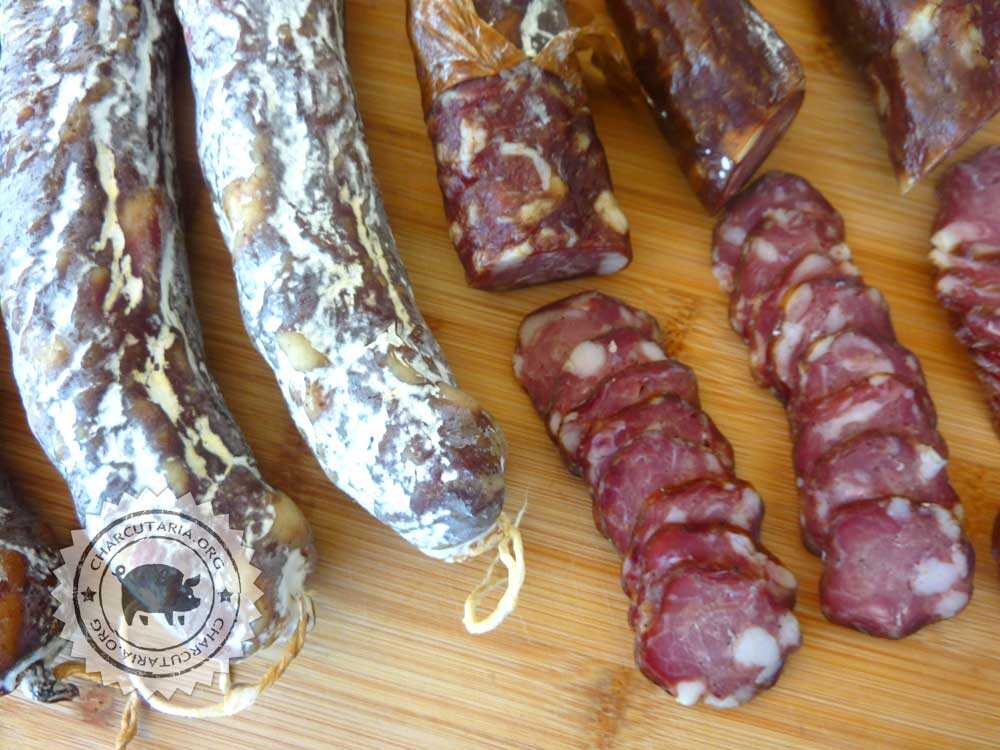
O salame colonial é um salame brasileiro muito comum no sul do Brasil, o salame colonial foi adaptado de receitas vindas da Europa por imigrantes principalmente alemães e italianos. O salame colonial geralmente é feito sem o uso de um ambiente climatizado durante o processo. Como o Brasil tem clima bem mais quente do que a Europa durante quase todo o ano, o salame teve que sofrer algumas adaptações para poder ser feito em nosso clima.
O processo de perda de água/maturação foi reduzido e acrescida uma etapa de defumação(a defumação em salames é comum na Alemanha). A defumação aplica uma camada de fumaça no exterior do salame e garante mais proteção contra contaminações e insetos. Para poder ser feito em temperatura mais elevada o salame colonial passa por um processo de defumação e depois é pendurado em temperatura ambiente por um período de tempo bem curto, que é de cerca de 7 a 15 dias. Por ficar pouco tempo secando, o salame colonial tem consistência mais mole do que os salames tradicionais, principalmente os italianos, que ficam pendurado por 30 dias ou muito mais.
Para facilitar ainda mais a produção, nesta receita pulei a etapa de defumação e apliquei fumaça líquida no exterior dos salames. A fumaça em pó também pode ser usada, basta diluí-la em água antes de aplicar.
Particularmente prefiro o salame mais firme, então usei uma tripa fina, de 30mm, o que resultou em um salame firme mesmo com pouco tempo pendurado.
Aplique uma cultura tipo mofo/mold nos salames para obter o revestimento de mofo branco que protege contra outros mofos indesejados. Mofo indesejado é o problema mais comum. Para saber mais sobre o mofo em salames, clique aqui.
Ingredientes do salame colonial
- Pernil suíno – 1000g;
- Sal – 20g – 2%;
- Sal de cura 2 (6% de nitrito, 3% de nitrato e 93,75% de sal) – 3g – 0,3%;
- Alho em pó – 4g – 0,4%;
- Cebola em pó – 4g – 0,4%;
- Pimenta do reino moída – 3g – 0,3%;
- Pimenta branca moída – 2g – 0,2%;
- Vinho tinto – 50g – 5%;
- Noz-moscada moída – 2g – o,2%;
- Fumaça líquida – 10ml
Preparo do salame colonial
- Limpar a carne, removendo ossos, tecidos rígidos e mantendo a gordura;
- Cortar a carne e a gordura em cubos para passar pelo moedor;
- Moer usando o disco fino ou cortar finamente com uma faca;
- Acrescentar os ingredientes e misturar com uma batedeira orbital ou com as mãos até a massa ficar bem pegajosa;
- Embutir em tripa de colágeno, bovina reta ou torta, nos calibres entre 30 e 45. Utilizei uma tripa bovina torta calibre 30;
- Com uma agulha, furar as bolhas de ar que ficaram presas dentro do salame;
- Passar a fumaça líquida no exterior do salame. Cobrir bem todo o exterior;
- Pendurar em um local ventilado, protegido de insetos e ao abrigo da luz. Utilizei uma caixa plástica semi-fechada com uma ventoinha instalada na parte de dentro para forçar a ventilação leve e constante; clique aqui para mais detalhes da caixa
- Borrifar uma cultura tipo mofo/mold nos salames caso queira o revestimento de mofo branco que protege contra outros mofos indesejados; Para saber mais sobre a cultura mofo mold, clique aqui.
- Após 7 a 15 dias o salame estará pronto.
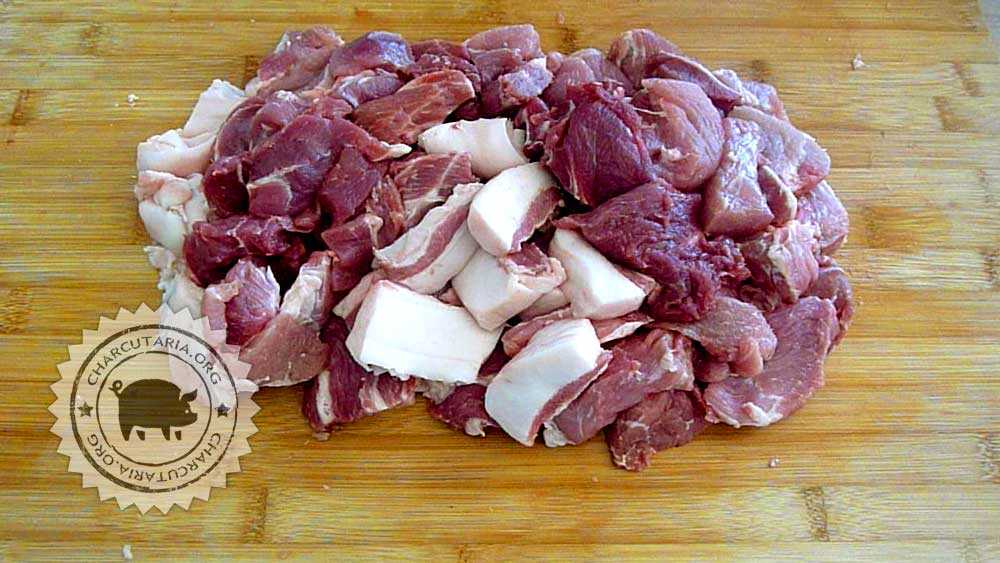
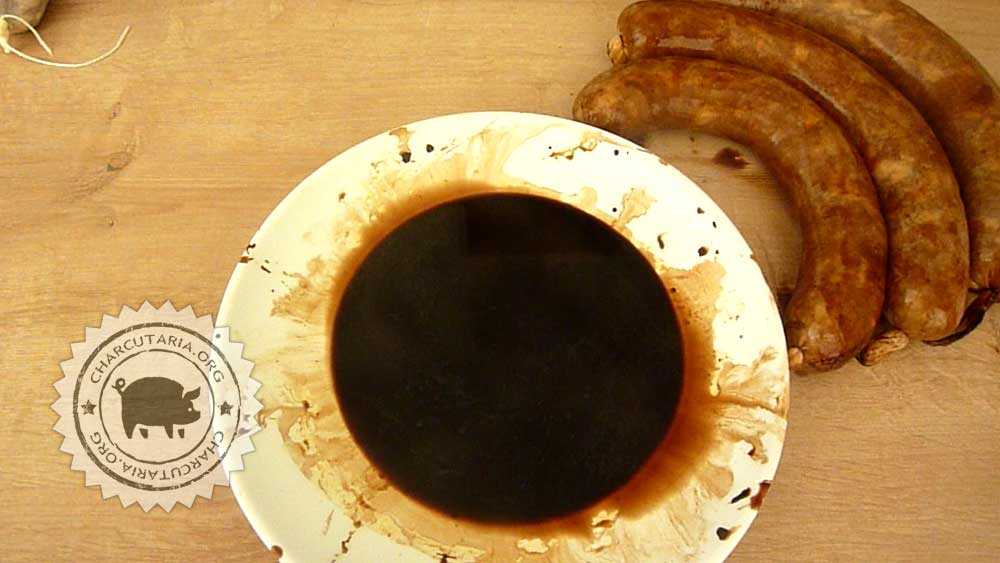
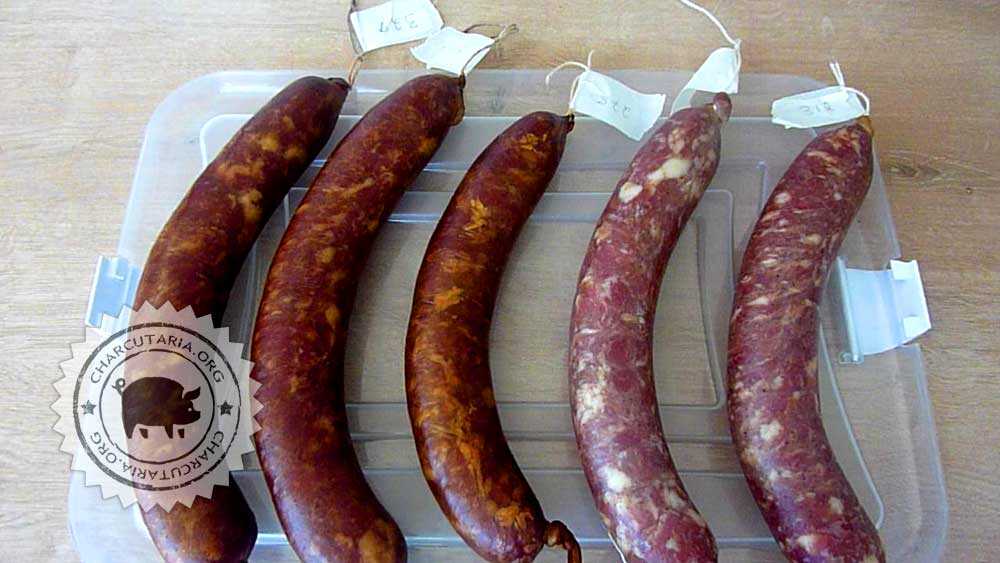
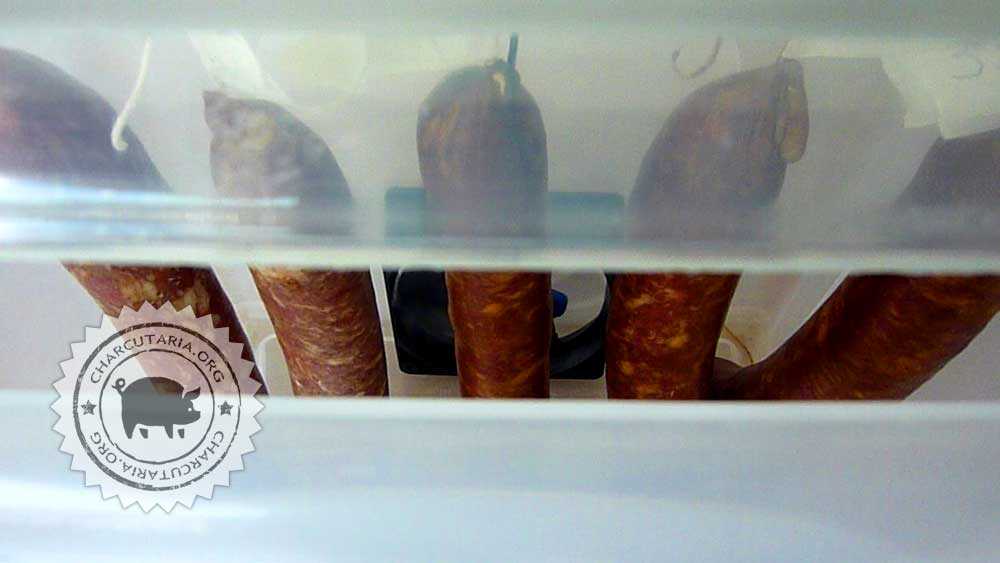






Bom dia, ótima receita! Mas eu tenho uma dúvida. Eu fiz o salame e utilizei o mofo 600, os salames ficaram bem branquinhos. Estão 15 dias de maturação. Armazeno em uma geladeira a 15 graus. Porém hoje notei um cheiro de amonia ao abrir a geladeira. O que pode ser?
Julio, o cheiro de amônia ocorre quando o mofo cresce demais, a parte do mofo que está mais próximo da tripa começa a morrer sufocado pela camada de mofo externo e exala este cheiro no processo. Neste caso recomendo que raspe o mofo em excesso, deixando apenas uma camada bem fina do mofo. Para evitar que ele cresça exageradamente, pode reuzir um pouco a temperatura, aumentar a ventilação ou seguir raspando quando crescer demais. Para entender melhor, assista esta entrevista com os especialistas da fabricante: https://www.youtube.com/watch?v=9CTv1zehRBg
Olá. Boa Noite!
Tenho uma dúvida: esse salame, segundo consta na receita, tem um tempo de cura de 07 a 14 dias. Tenho lido a respeito do sal de cura tipo 2 e há uma recomendação para que tenha um tempo mínimo de cura de 20 dias, para poder ter segurança em relação a concentração de nitrito na carne. Gostaria de saber se não é perigoso para saúde consumir um produto com menos de 20 dias de cura em que se utilizou sal de cura tipo 2? Obrigado!
Oi Vinicius. O sal de cura 2 tem nitrito e nitrato. O nitrito é reduzido em tempo bem curto, temos um artigo mostrando isso (Tempo de conversão do nitrito nas carnes curadas), já o nitrato é que precisa de mais tempo, pois é reduzido com o tempo e convertido em nitrito para só depois disso atua na carne. A quantidade de nitrato é bem pequena em comparação com o nitrito no sal de cura 2. De todo modo, em uma dieta tradicional, o nitrato é, em maioria, ingerido através de muitas verduras e legumes que contém quantidades altas de ntirato naturalmente, portanto a ingestão é bastante segura e comum mesmo para quem não consome embutidos. A quantidade sugerida de uso do sal de cura em nossas receitas é bastante baixa, é o mínimo para auxiliar na proteção. Outro ponto é que esses produtos são consumidos lentamente, dificilmente um salame é consumido por uma única pessoa em poucos dias. Durante esse tempo de armazenamento o restante do nitrato continua sendo convertido e auxiliando na proteção. Portanto, do meu ponto de vista, não há risco fazendo uso nas quantidades mínimas, tanto que muitas linguiças de churrasco comerciais atualmente usam o sal de… Leia mais »
Bom dia!! O meu salame às vezes fica com fissuras internas, não fica compacto. O que pode estar acontecendo?
Oi, pode misturar por um pouco mais de tempo a massa até ela ficar bem pegajosa, para ter uma boa coesão. Tente embutir sem deixar ar entrar no meio e aperte um pouco para compactar bem. Outra coisa que pode gerar espaços internos é o excesso de acidez, se estiver usando vinho, pode reduzir um pouco, se estiver usando cultura starter, diminua um pouco a quantidade de açúcar da receita. Outra coisa que pode gerar os espaços é alguma contaminação desconhecida que gera gás carbônico, mas geralmente também é associado à descoloração na região.
Muito obrigado pelas dicas!!
Bom dia. Desculpe o incômodo. Tenho uma última dúvida. Posso fazer essa mesma receita na caixa com a ventoinha e controle de umidade na geladeira? Consegui deixar na caixa a temperatura de 10C e 70% de umidade. Continuaria sendo 15 dias nessas condições? Ou vai demorar mais tempo?
Oi Andriel, pode fazer sim, ambiente ótimo nessas condições. Continuam sendo os 15 dias para o salame colonial tradicional mais macio, que é um pouco cru ainda. Caso queira um salame mais tipo italiano, mais sequinho, firme, basta deixar mais tempo neste mesmo ambiente, até perder 40% a 45% do peso. Pode ir testando e mantendo pelo tempo que achar ideal para o produto desejado. É muito do gosto esse ponto.
Bom dia. Posso fazer essa receita dentro da caixa fechada com a ventoinha de computador apenas pra controlar a umidade deixando fora da geladeira? A temperatura aqui está entre 17 e 25 graus. E quanto ao ambiente, precisa ser em local escuro ou pode ser um ambiente com claridade?
Oi Andriel, esse salame, se for bem defumado, consegue deixar em um ambiente sem refrigeração nesta temperatura que citou. Os produtores coloniais fazem desta forma, mas é um salame que fica pouco tempo pendurado, é finalizado ainda bem macio, com cerca de 15 dias. Se ficar muito tempo nesta temperatura tem risco grande de estragar.
Usei fumaça liquida e pendeurei numa caixa ventilada com um pouco de agua pra nãodeixar a temperatura passar de 25. Esta funcionando. Então após os 15 dias devo armazenar de que forma? Tem perigo deixar pendurado tipo os que compramos no mercado?
Oi Andriel. O ideal é, depois dos 15 dias, levar para a geladeira, para manter refrigerado e protegido. Pode embalar a vácuo ou com filme plástico ou pode deixar só em uma gaveta de frios mesmo, mas ele vai secar rapidamente o exterior sem embalar(se não considerar um problema, pode deixar). Esse salame colonial, que ainda é bem úmido, não recomendo deixar mais tempo pendurado em temperatura ambiente. O calor e a disponibilidade de água são muito férteis para fungos e bactérias, só os salames mais sequinhos, tipo italianos, é que aguentam mais tempo em temperatura ambiente. Mas muitos mercados e produtores acabam deixando mais tempo exposto, vai da receita e da garantia de segurança que quer ter.
bom dia Eduardo, estou comecando agora no mundo da charcutaria, fiz pela primeira vez o salame colonial, porem as pecas apos maturacao nao ficam bonitas, mas o sabor ok, o que pode ser?
O que desagradou na aparência?
Consigo fazer uma defumação a quente ? Se sim qual temp interna e tempo de fermentação é necessário
Oi Luiz, poder pode, mas terá um produto cozido e não maturado. O correto é defumar até uns 40ºC no máximo e depois pendurar para fermentar e maturar, perder umidade gradativamente e desenvolver os sabores e amoras da maturação. A temperatura da fermentação deve ser de 25ºC.
Olá, gostaria de saber, já faz mas de 1 ano, que faço salame colonial, bacon defumado e linguiça Toscana, que são congelada, nas minhas receita eu só utilizo sal de cura2, no percentual de 0,25% por kg de carne, outros ingredientes em pó natural.
Todos que consumiram, aqui em casa não reclamou ou passo mal.
Estou no caminho certo, ou tenho que mudar minha receita, para um futuro pode comercializar.
Olá! É possível usar uma tripa de calibre maior?
Caso utilize tripa de calibre maior os tempos mudam. Quanto maior o calibre da tripa, mais tempo o salame precisa ficar pendurado para perder peso.
Na receita está Está vinho tinto e suave ou seco…50 Gr e equivalente a 50 ml….
Preferencialmente vinho seco. Tinto ou branco, conforme preferir. 50g ou 50ml, vai dar pouca diferença na variação da densidade da água e do vinho(álcool e demais compostos), pode usar a medida que for mais fácil.
E nessesario estalar a ventoinha ou só deixar pendurado em um lugar fresco e arejado….
Local arejado já é suficiente. Só precisa de ventoinha caso o local seja tenha muito pouca circulação de ar, como um porão fechado, por exemplo.
Uma outra dúvida a fumaça líquida vai dentro com a mistura da carne ou e só por fora…
Na minha região a temperatura varia entre 13°
a 28° como fazer nesse caso…
Pode colocar a fumaça líquida na massa, junto com os temperos, e depois passar por foram também para garantir mais proteção. Com 13ºC é perfeito, já os 28ºC podem ser aceitáveis caso seja mais eventual e por pouco tempo. Faça nos momentos em que for fazer mais frio, acompanhe a previsão.
Boa noite tô para fazer mas estou com algumas dúvidas assim que eu temperar a e já posso ensacar
Outra coisa não vai na geladeira nenhum momento
Sim, pode ensacar logo após temperar. Como esse salame é bem rápido, então pode deixar fora da geladeira. Ideal fazer quando a temperatura ambiente estiver abaixo de 25ºC.
Olá, poderia me esclarecer se eu posso utilizar algum fermento carneo nessa produção? O clima aqui da região gira em torno de 15 a 24 nesta época eu queria deixar ele curando em uma sala bem ventilada com uma boa umidade, mas sem controle climático.
Pode usar uma cultura fermentadora. Nessas condições citadas creio que não terá problemas sem o controle climático.
Fiz minha segunda producao de salame, embuti ontem e a aparência está linda mudei algumas coisas que fiz errado com a ansiedade na primeira pequenos detalhes, além de entrarmos no outono aqui o clima está perfeito para a cura do salame está lindo demais vou mandar uma foto depois para que todos possam verem, o primeiro ficou bom mas esse vai ficar infinitamente melhor obrigado pelas dicas e o pronto atendimento para sanar as dúvidas.
Quero me aventurar num salame hamburguês vai ser a proxima produção
Oi Robson, envie as fotos quando puder! Um grande abraço.
Boa tarde, fiz essa receita de salame e está com 4 dias de cura alguns já perderam 40% de peso voi deixar curar mais por não está bem duro aindae sinto pelo cheiro que tem que apurar mais os temperos, mas estão com a aparência linda, criaram o mofo por fora, acredito que mais uma semana já vai está do ponto que eu pretendo, apliquei fumaça líquida tbem.
Sinto que ele não está ainda com aquele cheiro do salame curado bem ainda isso é normal ?
Lembrando que são 4 dias de cura ?
Obrigado
Oi Robson, em 4 dias foi bem rápida a perda de 40%. O ambiente deve estar bem seco para que isso tenha ocorrido. Com 4 dias é normal ele não ter desenvolvido o cheiro de salame curado. O salame colonial tem processo rápido e consequentemente não tem aquele sabor e aroma dos salames mais longos, com 30/40 dias. Ele também costuma ter o miolo mais macio. É uma característica deste produto. Pode deixar até uns 15 dias caso queira que ele fique mais firme e ganhe o cheiro mais intenso de salame curado.
Bom dia, na receita do salame colonial vc pulou a etapa de defumaçào, e no caso de defumar qual a temperatura durante o processo e a cultura borrifo depois ou antes de defumar?
Oi Alexandre, sim, optamos por usar a fumaça líquida ao invés de defumar, para agilizar e facilitar a produção de quem não tem um defumador. A temperatura que recomendo é de até 35ºC e o tempo pode variar muito conforme a intensidade de fumaça que deseja incorporar. No mínimo umas 4 horas. Borrife a cultura penicilium nalgiovense depois da defumação.
Olá Eduardo,
Muito legal suas receitas.
Tenho uma dúvida, na questão desse salame, vc não usa a cultura start mas coloca vinho, que também vai acidificar o produto.
Minha dúvida é em relação ao controle de pH, para quem não tem um medidor de pH, como saber se o processo de acidificação foi realizado e o salame é próprio para consumo? se ele estiver improprio vai ter alguma característica?
Abçs,
Oi Mauricio. Sem o medidor de pH não há como ter certeza, mas é possível seguir as recomendações. Com a cultura starter que temos na loja, por exemplo, ao adicionar 0,5% de açúcar à receita, a fermentação culminará em um pH próximo ao ideal. Já com o vinho é mais difícil, pois os vinhos pode variar entre si. Ao usar vinho sem uma cultura starter estamos às cegas. O vinho vai dar um pouco mais de proteção, mas o resultado é impreciso. O produto final apresenta alterações sim, geralmente o pH alto(mais alcalino) resulta em um salame com coloração mais fraca, um vermelho menos intenso. Já um pH baixo(ácido) geralmente resulta em um salame com textura ruim, quebradiço e azedo.
Obrigado Eduardo.
o meu salame está com uma coloração bonita por fora está com 10dias e perdeu quase 20% na camâra.
vamos ver se não vai estar azedo qdo fica pronto! rs
abçs,
Olá sou morador de Mato Grosso, quero entrar nesse ramo de linguiças e salames, a dúvida q tenho é se o sal, o sal de cura e os demais ingredientes tem q ser medidos conforme o peso da carne limpa (sem gordura) ou medido conforme o volume total (carne e gordura). Outra dúvida é a proporção do alho em pó para o alho picado, pois prefiro usa-lo normal sem ser em pó e na maioria das vezes suas receitas pede em pó. Poderia me ajudar? Desde já muito obrigado.
Oi Mateus. Pode considerar o peso total da carne, com a gordura. Não precisa desconsiderar a gordura pois essa quantidade de sal de cura que sugerimos já é o mínimo recomendável, então mesmo que haja uma parte em gordura não fará muita diferença. Com relação ao alho, usando o fresco pode dobrar a quantidade. O alho cru tem muita água, portanto é bem menos concentrado.
Muito obrigado pela breve resposta, isso vale para o sal comum também né?
Sim, vale para o sal comum também.
Boa tarde, Eduardo,
Eu fiz esse salame há algum tempo, segui estritamente a receita e ficou perfeito.
Há poucos dias chegou a cultura que eu comprei em seu site e o clima por aqui, embora muuuito quente, parece que vai melhorar com a chuva anunciada. Eu quero aproveitar essa janela e fazer uns salames e esse está no topo da lista….só que dessa vez eu queria usar a cultura, será que vale a pena? Fica melhor?
Minha intenção é também fazer a defumação a frio, ao invés de usar a fumaça…nesse caso qual o tempo recomendável para essa defumação?
Desde já agradeço!
Abs
Boa noite José. Use a cultura sim, vale a pena! Para defumar e usar a cultura, siga a receita, acrescentando, junto com os demais ingredientes, a cultura starter e 5g de açúcar por kg de carne, ensaque mas não passe pela fumaça líquida. Pendure por 2 ou 3 dias em temperatura ambiente para fermentar, depois defume a frio por 4 a 8 horas, conforme a intensidade de defumação desejada. Pendure por 7 a 15 dias até perder o peso desejado. Tire ou reduza um pouco o vinho da receita pois a cultura já vai acidificar o salame.
Caso queira uma referência adicional, tem essa receita de salame tipo hamburguês que é defumado a frio: https://charcutaria.org/receitas/salame-hamburgues/
Por quanto tempo ele poder ser armazenado dpois de pronto?
Salames duram em média 90 dias. Armazene bem embalado na geladeira.
Olá Eduardo.
Qual a temperatura desejável para se manter o salame colonial? Caso queira utilizar a fumaça em pó, devo reduzir o sal do tempero.
A temperatura ideal é de 12ºC. Acredito que a quantidade de fumaça em pó seja pequena e não chegue a influenciar significativamente a concentração de sal do produto, mas, caso queira, pode reduzir um pouco o sal da receita de acordo com a quantidade de fumaça em pó que utilizar.
Olá, qual a temperatura desejável para se manter o salame colonial.
Olá Eduardo!!
Como sempre suas receitas são infalíveis e ficam sensacionais… Essa foi mais uma das muitas que sigo.
Pena que não consigo comprar os insumos com vc, o frete fica proibitivo.
A foto não tinha ido!
Que bom! Ficou com aparência ótima. Fico feliz que esteja aprovando as receitas. Um grande abraço!
Oi Rodrigo. Para algumas regiões o frete fica bem caro mesmo, uma pena!
Boa noite, Eduardo,
Eu fiz uma copa (copa artesanal, mas usei vinho em substituição à cultura), passou os 15 dias na geladeira e já está maturando na solução de caixa plástica…fiz também o salame cacciatore. Para o salame eu usei yakult e raspas de queijo brie. Fermentou por 48 horas, apareceram muitos pontinhos brancos bem pequenos, mas agora está aparecendo algumas manchas branco/acinzentadas, com alguns pelinhos…amanhã devo tirar essas manchas…caso eu compre a cultura starter, após limpar a copa e salame, posso aplicar a cultura? Como eu faço para conservar a cultura? pois vou usar muuuito pouco, como não é barato, queria saber se posso armazenar sem perda de qualidade. Desde já mto obrigado! A cultura que quero comprar é que está na loja do site.
Oi José Roberto. A cultura deve ser armazenada no congelador. Use o necessário, feche bem na embalagem original e mantenha no congelador. Tem boa durabilidade desta forma. A cultura para o mofo branco deve ser a cultura penicillium, que é diferente da cultuar starter bacteriana.
Cultura penicillium: https://charcutaria.org/produto/cultura-mofo-mold-penicillium-nalgiovense/
Bom dia! Vejo muitas receitas de charcutaria e, sempre quando a fonte é brasileira ou americana, é utilizado sal de cura e muitos ainda destacam sua importância. Contudo, em canais e sites italianos é o contrário; nas receitas que vi só era usado sal normal. Inclusive, em documentos do governo italiano que determinam os padrões de certos produtos protegidos pela origem, o sal de cura é geralmente opcional ou nem citado.
Gostaria de saber o pq dessa diferença de abordagens sobre produtos curados.
Desde já, muito obrigado e parabéns pelo trabalho!
Oi Guilherme, no Brasil o uso do sal de cura nos embutidos destinados à comercialização é obrigatório, com poucas exceções como o charque brasileiro. Muitos outros países também adotam essa política de exceções, como, por exemplo, o presunto parma italiano. Temos um clima desfavorável e a cadeia de frio(transporte, geladeiras e balcões refrigerados) não é das melhores, então temos essa obrigatoriedade legal, virou cultura que faz parte do paladar do brasileiro. A linguiça sem o sal de cura tem cor e sabor diferentes. O nitrito do sal de cura já passou por décadas de estudos bem minuciosos e é bem documentado que seu uso é seguro dentro dos limites. Inibe patógenos perigosos, aumenta o tempo de prateleira, fixa a cor vermelha da mioglobina e reduz a oxidação. Sempre uso o mínimo recomendável. As alternativas que encontraram e usam, principalmente na Europa e EUA, são as fontes naturais de nitrato(vegetais), que tem o complicador de necessitar de um agente redutor(nitrato para nitrito) e no final das contas é exatamente o mesmo composto químico, só que extraído de vegetais e com o termo “cura natural”. Outro fator que deve observar nos produtos sem o sal de cura é a concentração de sal,… Leia mais »
Não precisa fermentar o salame?
Fermentação é opcional e deve ser feita só quando utilizar uma cultura starter. Para salames mais rápidos geralmente não faço a fermentação pois a proteção adicional é menos necessária e não haverá muito tempo para o desenvolvimento do sabor mais elaborado da maturação longa em conjunto com a cultura.
Em caso de utilizar a cultura starter e precisar de fermentação, devo utilizar a fumaça líquida antes ou depois da fermentação?
Aplique a fumaça logo após a etapa de fermentação pois ela pode inibir a proliferação.
Bom dia …posso usar cultura starter 0,15 g p/ 1kg de carne e ainda assim borrifar a mofo mold? Posso usar ambas na mesma peça, ou um ou outro?
Oi Célio, pode usar as duas culturas. A starter bacteriana diretamente na massa do salame e a cultura mofo no exterior após embutido.